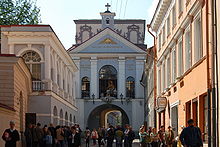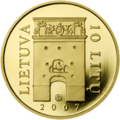Gate of Dawn
This article needs additional citations for verification. (June 2013) |



The Gate of Dawn (Template:Lang-lt), or Sharp Gate (Template:Lang-pl, Template:Lang-la, Template:Lang-be, Template:Lang-lt, Template:Lang-ru) is a city gate in Vilnius, the capital of Lithuania, and one of its most important religious, historical and cultural monuments. It is a major site of Catholic pilgrimage in Lithuania.
History
It was built between 1503 and 1522 as a part of defensive fortifications for the city of Vilnius, the capital of the Grand Duchy of Lithuania. It has also been known as the Medininkai Gate, as it led to the village Medininkai south of Vilnius, as well as Aštra broma.[1] Of ten city gates, only the Gate of Dawn remains, while the others were destroyed by the order of the government at the end of the 18th century.[2]
Our Lady of the Gate of Dawn
In the 16th century city gates often contained religious artifacts intended to guard the city from attacks and to bless travelers. The Chapel in the Gate of Dawn contains an icon of The Blessed Virgin Mary Mother of Mercy, said to have miraculous powers.[3] For centuries the picture has been one of the symbols of the city and an object of veneration for both Roman Catholic and Eastern Orthodox inhabitants. Thousands of votive offerings adorn the walls and many pilgrims from neighboring countries come to pray in front of the beloved painting. Masses are held in Lithuanian and Polish languages.
After World War II the cult of Our Lady of the Gate of Dawn prevailed in Lithuanian and Polish communities worldwide and is continued in many shrines to the Virgin Mary in Europe, and the Americas. The largest of the churches devoted to Our Lady of the Gate of Dawn is St. Mary's Church in Gdańsk, Poland.
The shrine is also important in the development of the devotion Divine Mercy as it is the first place where the Divine Mercy image was exposed and also where the first celebration of the Divine Mercy Sunday took place.[4]
On 4 September 1993 Pope John Paul II said Rosary at the Gate of Dawn Chapel. Church festival of the Blessed Virgin Mary Mother of Mercy—celebrated in the third week of November—is of great importance in the Vilnius Archdiocese.
Lithuanian Chapel in the St. Peter's Basilica in Vatican City
There is a Vilnius' Gate of Dawn Mother of Mercy Chapel (Template:Lang-it) in the St. Peter's Basilica in Vatican City.[5] It was consecrated by the Pope Paul VI in 1970 and it is a place where Pope John Paul II had his first prayer after being elected as the Pope in 1978. Only Lithuania, Poland, Hungary and Ireland have such chapels in the St. Peter's Basilica.[6]
Legacy
- The landmark is mentioned in a poem of Maksim Bahdanovich Pahonia (1913) and its emblem Pahonia, as well as in Pan Tadeusz.[7]
Gallery
-
Southern view as seen in 1845
-
Our Lady of the Gate of Dawn (1847)
-
Gate of Dawn (1864)
-
Vytis as depicted on top of the gate
-
Litas golden coin featuring the gate
References
- ^ Jurginis, Juozas (1987). Aušros vartai. Pokalbiai su tikinčiuoju (in Lithuanian) (2nd ed.). Vilnius: Mintis. pp. 3–37. OCLC 19353894. Archived from the original on 9 November 2014.
- ^ ""The Gates of Dawn", Lithuanian State Department of Tourism". Archived from the original on 8 December 2017. Retrieved 12 November 2017.
- ^ "The Gate of Dawn", Travel Lithuania
- ^ ""The Gate of Dawn - Vilnius", Catholic Chaplaincy: University of Glasgow". Archived from the original on 2 February 2015. Retrieved 25 June 2013.
- ^ "Lithuanian Chapel of Our Lady Mater Misericordiae". saintpetersbasilica.org. 14 February 2014. Archived from the original on 14 February 2014. Retrieved 6 October 2019.
- ^ "Lietuvių koplyčia Vatikane: vieta, į kurią po išrinkimo popiežiumi iš karto atėjo pasimelsti Šv. Jonas Paulius II". itlietuviai.lt (in Lithuanian). Retrieved 6 October 2019.
- ^ See the relevant fragment of Adam Mickiewicz "Pan Tadeusz" epic poem: "Panno święta, co Jasnej bronisz Częstochowy I w Ostrej świecisz Bramie"; Translation: "Holy Virgin who shelters our bright Częstochowa And shines in Ostra Brama!"; Comment: Invocation to Mary, Mother of God, represented in two paintings considered the most sacred icons of Poland and Lithuania respectively: the Black Madonna of Częstochowa and Our Lady of the Gate of Dawn, or Ostra Brama, in Vilnius." - See: http://en.wikiquote.org/wiki/Pan_Tadeusz; see also Włodzimierz Szpak documentary film entitled: ...I W OSTREJ ŚWIECISZ BRAMIE ("...AND SHINES IN OSTRA BRAMA".
External links
 Media related to Gate of Dawn at Wikimedia Commons
Media related to Gate of Dawn at Wikimedia Commons- Catholic Church in Lithuania | Aušros Vartai
- The Congregation of the Sisters of Merciful Jesus
- 1522 establishments in Europe
- Infrastructure completed in 1522
- Gates
- Buildings and structures in Vilnius
- Renaissance architecture in Lithuania
- Neoclassical architecture in Lithuania
- Shrines to the Virgin Mary
- Roman Catholic shrines in Lithuania
- Votive offering
- Tourist attractions in Vilnius
- Divine Mercy
- Objects listed in Lithuanian Registry of Cultural Property





